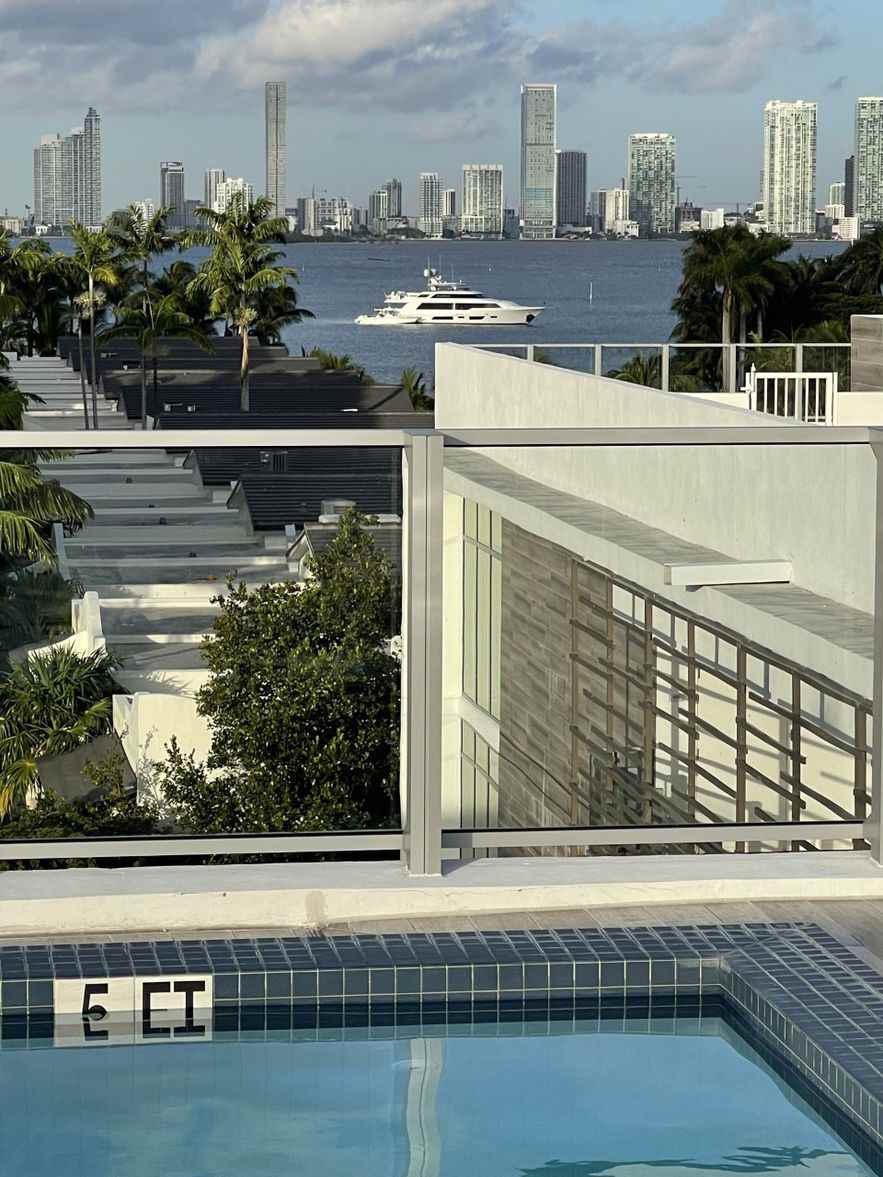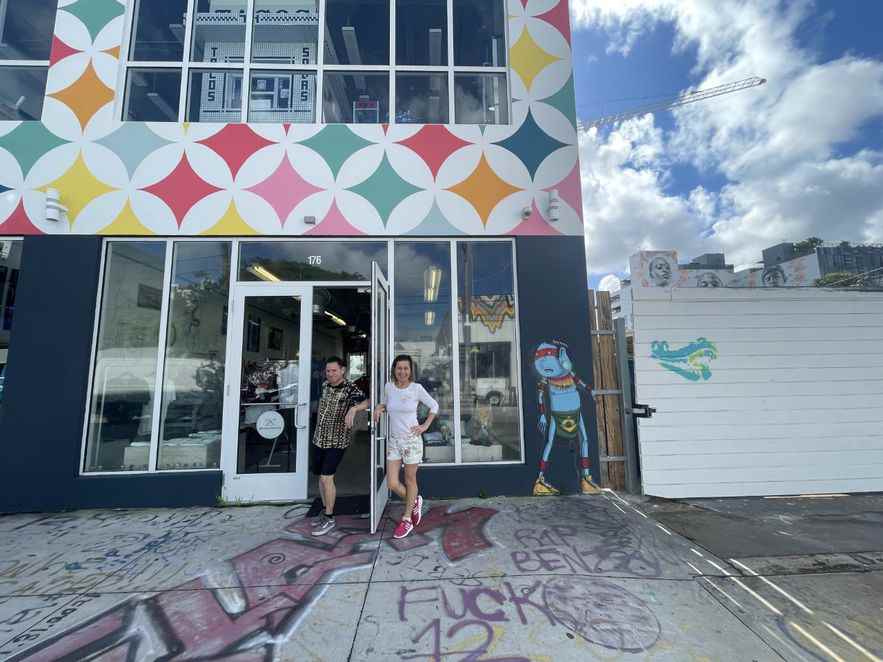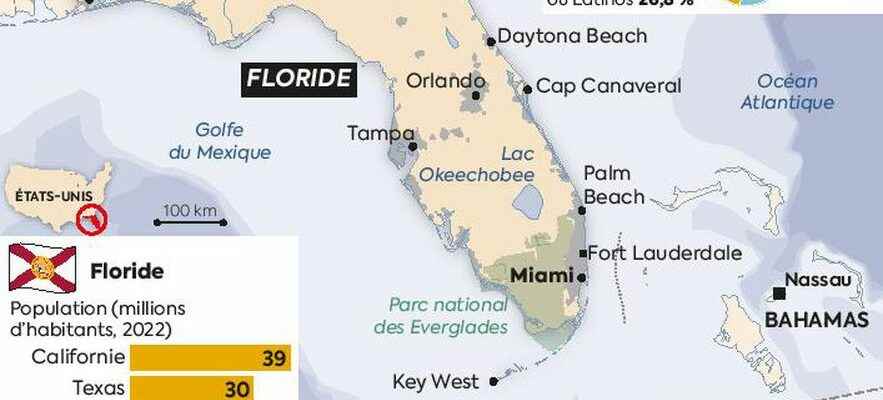Alligators, mosquitoes and only 1 million Americans. This is what Florida looked like 100 years ago, a suffocating and almost unlivable state, then largely covered by the Everglades swamp. But that was before the “air conditioning”. From the 1950s, the Sunshine State established itself as a tourist destination and the privileged place of residence for retirees. For a long time, the place where 22 million Americans currently live (they will be 25 million in 2032) was considered old-fashioned and superficial. But in America everything can change very quickly. Today, the adopted land of Shakira, Tiger Woods, the late Gianni Versace and Donald Trump – he resides in Mar-a-Lago, his rococo palace in Palm Beach – becomes “the place to be”.
Florida, the 3rd most populous state in the United States
© / Infographic Dario Ingiusto
“In the past, people came here to visit their grandparents or end their days there themselves; now people in their forties from Wall Street and Silicon Valley come to settle their families, relocate their businesses, build their lives”, observes Christopher McKnight, an entrepreneur who said goodbye to New York four years ago to run his business remotely from Parkland, a residential community north of Miami home to one of Florida’s 1,100 golf courses (and where, five years ago, fourteen students lost their lives in a school shooting).
“In New York, where I maintain a remote surveillance company, I was exhausted at work. Here, I discover a new way of life, he explains, seated in a shopping center in Aventura, in the northern suburbs of Miami. I wake up under a blue sky, I savor my coffee in the garden, I look at the palm trees around and I say to myself: I will never go back to live in Manhattan.
This 40-year-old is not the only one to have swapped the tie suit for the trainer T-shirt. Every day, a thousand Americans land in Florida. They come from everywhere: from New York and Boston, from the Midwest (Chicago, Minneapolis, Detroit), from Seattle (northwest of the country), from California. In one decade, the population has increased by 15%, at a rate twice as high as the rest of the United States (331 million souls). And in the last three years, it has gained 1 million inhabitants. Now the third most populous state after California and Texas, Florida overtook New York in 2014.
Following the last census, a twenty-eighth seat was allocated to Florida’s representation in the Washington Congress to reflect its demographics. Conversely, the states of New York, Illinois, Michigan and Pennsylvania lost one seat. Texas, meanwhile, won two seats. This is a major trend known to demographers: a movement of internal migration is underway, from North to South.
In Florida, the candidates for the succession of Joe Biden jostle
Politically, Florida weighs more and more. No less than five Republican candidates are looming for the 2024 presidential election: Donald Trump, Governor Ron DeSantis, the two senators Marco Rubio and Rick Scott and the energetic mayor of Miami Francis X. Suarez who wants to make his city the capital. cryptocurrency world. “The next president of the United States will be from Florida!” Wants to believe Republican deputy from Florida Mario Diaz-Balart – whose aunt was Fidel Castro’s first wife! -, which excludes a re-election of octogenarian Joe Biden.

View of Miami from Miami Beach, Florida
© / AG
Economically speaking, Florida’s prosperity is everywhere visible to the naked eye. In Miami, for example, which encompasses two municipalities – the slender island of Miami Beach, facing the ocean, and Miami tout court, on the mainland, where the business district is located –, the skyscrapers of the skyline are three times more numerous than a decade earlier. Buildings and villas are being built everywhere. The yachts, the shopping mallsrestaurants, fashion boutiques, gyms, hotels with swimming pools and art galleries are multiplying like hotcakes.
Once non-existent, traffic jams are daily. “The rush hour starts at 3:30 p.m. instead of 4:30 p.m. three years ago!” remarks Viviane Gude, a Cuban-American who arrived in Florida in the 1960s. ! When the traffic is fluid, some slalom at breakneck speed like in a chase of the series Two cops in Miami (miami vice). Times are changing: the danger in “Magic City” (Miami’s nickname) is no longer crime, which is in freefall, but road accidents.
“Florida is freedom! This is real America!”
But why does Florida, like California in the past, attract like a magnet? Part of the answer lies in one word: taxation. Like seven other states, including Texas and Alaska, Florida does not collect income tax. Here, only the federal state collects taxpayers. “In New York, where I lived for twenty years, I was taxed at 54%, details, in Palm Beach, fund manager Paul Epstein, a fifty-year-old whose income is in the upper bracket. Here, I pay only 37% Knowing that in New York private tuition easily reaches $40,000 a year and that, conversely, public schools here are of good quality, I saved a bunch of money. money by moving to the sun”, welcomes this fifty-year-old millionaire.

Florida Governor Ron DeSantis after a building collapsed in Surfside, north of Miami, July 03, 2021.
© / Getty Images via AFP
The other key to success is the policy in the face of Covid-19. After six weeks of beach closures, Republican Governor Ron DeSantis is changing his tune: there will be no confinement, no vaccinations, no wearing of mandatory masks during the pandemic. “Florida is freedom; here, it’s the real America, like in the days of Ronald Reagan”, resumes the entrepreneur in a T-shirt and sneakers (and not vaccinated) Christopher McKnight, delighted to have left New York ” and his bullshit Democrat”. Result? The record is hardly different from that of California where the rules were strict. It is therefore not surprising that the governor was re-elected last November with a 19-point lead over his opponent. It must be said that with unemployment at 2.5% and all the indicators in good shape, everything is smiling in Florida, even the sports results: the footballers of the Tampa Bay Buccaneers and the hockey players of the Tampa Bay Lightning have won their championships in 2021.
Started before the Covid, the rush to Florida has accelerated with telework. “Initially, we thought of returning to New York, but after having tasted the tropics, the temporary became permanent”, testifies the independent designer and father James Sanderson, who now lives, with his Latin American wife, thirty minutes from plane from the Bahamas and two hours from Costa Rica. David Zalben, another neofloridian, who runs the arty Pink Bastard boutique in Miami’s Wynwood neighborhood, agrees: “People may be less sophisticated here than in New England, but they’re friendlier. ” Actress Celia Gruss, a resident of Miami Beach for seven years, adds: “Here, there are hellish parties like the crazy one at the Bitcoin 2021 conference, with DJ Deadmau5 on the decks. It lasted three days, with fabulous sound and crazy laser effects. It felt like Ibiza in 1992!”, concludes, as a connoisseur, this follower of yoga and Governor DeSantis.

The Pink Bastards store in Miami’s Wynwood neighborhood
© / AG L’Express
Florida mania is also boosting real estate. Since 2020, prices have increased by 70%. Those of luxury accommodation are soaring. “On the island of Palm Beach, there is nothing left to sell, notes the real estate agent Ines Flax. But in Miami, on Star Island, the private island with thirty exceptional villas – Madonna owned the hers; Gloria Estefan still lives there – transactions are going well: six houses have changed owners this year and in 2021, compared to only one per year in previous years, which testifies to the vitality of the market.” Less expensive, apartments of 140 square meters with sea view are negotiated at “only” 1 million dollars.
For its part, the business district, in Miami-city, is undergoing a metamorphosis. In what was once a ghost town appear businesses, hotels, a huge Apple Store, and more. A “signature bridge”, with six giant arches across the sky, is under construction: it will soon give its visual identity to the metropolis. “Like Manhattan, our downtown will soon live twenty-four hours a day,” promises real estate developer and cruise line executive Russell W. Galbut. And soon, in 2023, Miami will be connected to Orlando by the Bright Line, a new rail line, financed entirely by the private sector.Then it will be extended to Tampa, also booming, on the west coast of Florida.
“Florida is the epicenter of all things cool!”
After driving on the Ronald Reagan Highway (which crosses the entire region), we disembark at the inauguration of a “bling-chic” restaurant on a rooftop in the trendy district of Wynwood, famous for its murals. Among the well-dressed men and the women in high heels, we find a local personality, Tara Salomon, who is sipping a cocktail under the starry sky, seated at the bar. Former people journalist at Miami Heraldnow at the head of a public relations agency, it is she who provides the “com” of the event, which coincides with the contemporary art fair Art Basel Miami [chaque année début décembre].
“Florida, and especially Miami, is the epicenter of everything cool: music, design, fashion, culinary arts, enthuses this child from the Sunshine State. Here, we define a new lifestyle where parties and telecommuting coincide. It’s in the air. The energy is there, palpable, fueled by the Latino melting pot, by the world of creators and by the money flowing in from everywhere.” And this is how Florida is reinventing the American dream.
